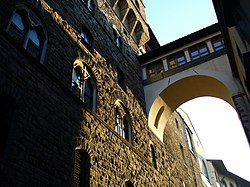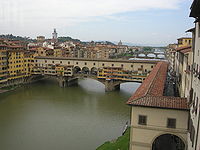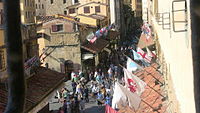Vasari Corridor
This article needs additional citations for verification. (February 2019) |
| Vasari Corridor | |
|---|---|
Corridoio Vasariano (Italian) | |
 The Vasari Corridor's bridge from the Palazzo Vecchio to Uffizi | |
 | |
| General information | |
| Town or city | Florence |
| Country | Italy |
| Current tenants | Uffizi Gallery |
| Year(s) built | 1565 |
| Design and construction | |
| Architect(s) | Giorgio Vasari |

The Vasari Corridor (Italian: Corridoio Vasariano) is an elevated enclosed passageway in Florence, central Italy, connecting the Palazzo Vecchio with the Palazzo Pitti. Beginning on the south side of the Palazzo Vecchio, it joins the Uffizi Gallery and leaves on its south side, crossing the Lungarno degli Archibusieri, then following the north bank of the River Arno until it crosses the river at Ponte Vecchio. At the time of construction, the corridor had to be built around the Torre dei Mannelli, using brackets, because the tower's owners refused to alter it. The corridor conceals part of the façade of the Church of Santa Felicità. It then snakes its way over rows of houses in the Oltrarno district, becoming narrower, to finally join the Palazzo Pitti. The corridor's full length is approximately one kilometre.
History and overview
The Vasari Corridor was built in five months by order of Duke Cosimo I de' Medici in 1565, to the design of Giorgio Vasari. It was commissioned in connection with the marriage of Cosimo's son, Francesco, with Johanna of Austria. The idea of an enclosed passageway was motivated by the Grand Duke's desire to move freely between his residence and the government palace, when, like most monarchs of the period, he felt insecure in public, in his case especially because he had replaced the Republic of Florence. The meat market of Ponte Vecchio was moved to avoid its smell reaching into the passage, and its place taken by the goldsmith shops that still occupy the bridge. At the latter extremity, the corridor was forced to pass around the Mannelli Tower, after the staunch opposition of that family to its destruction.
In the middle of Ponte Vecchio, the corridor is characterized by a series of panoramic windows facing the Arno, in the direction of the Ponte Santa Trinita. In 1939, these replaced the original windows, by order of Benito Mussolini. The larger windows were installed for an official visit to Florence by Adolf Hitler to give him a panoramic view of the river.
After the Ponte Vecchio the corridor passes over the loggiato of the church of Santa Felicita; at that point it had a balcony, protected by a thick railing, looking into the interior of the church, to allow the Grand Duke's family to follow services without mixing with the populace.
In its Uffizi section, the Vasari Corridor is used to exhibit the museum's famous collection of self-portraits.
In 2016 the corridor was closed for safety reasons and was set to re-open for tourists on 27 May 2022, marking the anniversary of the 1993 Via dei Georgofili bombing, after an 11-month renovation. The corridor was reopened on 21 December 2024.
Incidents
The area closest to the Uffizi entrance was heavily damaged by a bombing commissioned by the Sicilian Mafia on the night of 27 May 1993. When a car bomb was detonated next to the Torre dei Pulci, between via Lambertesca and via de' Georgofili, this section of the Uffizi Gallery was among the buildings damaged, and several artworks in the corridor were destroyed. These paintings, some irreparably damaged, have been pieced back together and returned to their original positions to serve as a reminder of the event.
In August 2023, graffiti was found spray-painted on seven pilasters of the corridor. Authorities accused two German tourists of being responsible, while the Italian Ministry of Culture said repairs would cost 10,000 euros ($10,811).
Gallery
-
The Corridoio seen from the Ponte Vecchio
-
Vasari's tile-roofed Corridoio running from the Uffizi (right), above the river bank and across the Ponte Vecchio on its way to link Palazzo Pitti
-
Street view of the Ponte Vecchio as seen from the Vasari Corridor
See also
- Passetto di Borgo, Rome
- Passages for Maria Maddalena de' Medici (incl. the corridoio mediceo), also in Florence
References
- ^ "History: Corridoio Vasariano". www.uffizi.it. Retrieved 2020-05-26.
- ^ "The Vasari Corridor". www.visitflorence.com. Retrieved 2020-05-26.
- ^ "Florence's 'secret' Vasari corridor to open to the public in 2021". www.thelocal.it. 2019-02-20. Retrieved 2019-02-26.
- ^ "A fatal Mafia bombing shook Florence in 1993—now the Uffizi is fixing damage to its famous Vasari corridor with memorials of the attack". The Art Newspaper. 2021-05-21. Retrieved 2021-05-24.
- ^ "The Vasari Corridor reopening". Uffizi Galleries. 12 May 2024.
- ^ Walrath-Holridge, Mary (24 August 2023). "German tourists suspected of defacing historic Italian landmark with graffiti". USA Today. Retrieved 25 December 2023.
External links
 Media related to Vasari Corridor at Wikimedia Commons
Media related to Vasari Corridor at Wikimedia Commons



